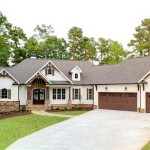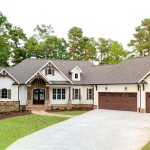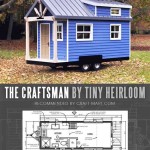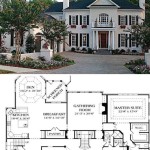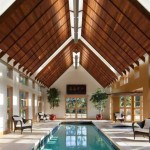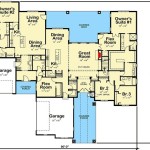House Plans: Exploring the Versatility of L-Shaped Homes
L-shaped house plans represent a popular and adaptable architectural design choice. Characterized by a layout that forms an "L" shape, either symmetrically or asymmetrically, these homes offer a unique blend of functionality, aesthetics, and site adaptability. Their inherent design facilitates natural light penetration, efficient zoning, and opportunities for creating private outdoor spaces. This article explores the key advantages, design considerations, and diverse applications of L-shaped house plans.
Advantages of L-Shaped House Plans
The appeal of L-shaped house plans stems from several inherent advantages. These advantages contribute to both the livability and the market value of the property.
One significant benefit is the efficient separation of living spaces. The two wings of the "L" naturally lend themselves to zoning, allowing for a clear distinction between public and private areas. For instance, one wing might house the bedrooms and bathrooms, creating a quiet and restful zone, while the other wing accommodates the living room, dining area, and kitchen, forming the main living and entertaining space. This separation minimizes noise transfer and promotes a more peaceful environment within the bedroom areas.
L-shaped designs are also adept at maximizing natural light. The shape typically allows for more exterior walls than a rectangular structure of comparable square footage. This increased wall space translates to more windows, enabling sunlight to penetrate deep into the interior. Strategic window placement can capitalize on solar orientation, optimizing passive heating and cooling strategies depending on the climate. Large windows and sliding glass doors in the connecting "elbow" of the "L" can further enhance light penetration and create a seamless transition to outdoor living areas.
Furthermore, L-shaped homes are well-suited for corner lots. The design can be oriented to maximize street frontage while simultaneously creating a private backyard oasis nestled within the "L". This enclosed space is ideal for patios, gardens, or swimming pools, offering a secluded and sheltered retreat. The "L" shape also provides opportunities to create a focal point within the landscape, drawing the eye towards a well-designed seating area or water feature.
Design Considerations for L-Shaped Homes
While L-shaped designs offer numerous benefits, careful planning is crucial to ensure optimal functionality and aesthetics. Several design considerations should be addressed during the planning phase.
Addressing circulation is paramount. The flow of traffic throughout the house should be intuitive and efficient. The junction of the "L" can become a natural hub, connecting the different zones of the house. However, it's important to avoid creating bottlenecks or long, dark corridors. Open floor plans and strategically placed doorways can enhance circulation and create a more spacious feel. The width of hallways should also be considered, ensuring comfortable passage, especially in areas that connect high-traffic zones.
Proper structural support is also crucial. The junction of the two wings requires careful engineering to ensure stability and prevent potential structural issues. Load-bearing walls, beams, and columns must be strategically placed to distribute weight evenly. Consideration should also be given to the type of foundation used, taking into account the soil conditions and the overall weight of the structure. Consulting with a structural engineer is highly recommended to ensure the structural integrity of the design.
Attention must be paid to the exterior aesthetics. The "L" shape can create interesting architectural opportunities, but it's important to maintain a cohesive and balanced appearance. The proportions of the two wings should be carefully considered, and the exterior materials should be chosen to complement the overall design. Consider using different textures and colors to accentuate different elements of the façade. A well-designed landscape can further enhance the curb appeal and integrate the house seamlessly into its surroundings.
Diverse Applications of L-Shaped House Plans
The versatility of L-shaped house plans allows them to be adapted to a wide range of architectural styles and site conditions. They are suitable for various applications, from single-family homes to multi-generational dwellings.
For single-family homes, the "L" shape can be used to create a spacious and open living area while maintaining privacy in the bedroom wing. The enclosed backyard space provides a safe and secure environment for children and pets. The design can also be easily adapted to incorporate features such as home offices, studios, or workshops. The orientation of the "L" can be adjusted to maximize solar gain in the winter and minimize solar heat gain in the summer, contributing to energy efficiency.
In multi-generational living situations, the "L" shape can be particularly advantageous. One wing can be designated as a separate living space for elderly parents or adult children, providing them with privacy and independence while still remaining connected to the main household. This arrangement allows for shared living expenses and mutual support while maintaining a sense of personal space. Separate entrances and kitchenettes can be incorporated into the secondary living space to further enhance independence.
L-shaped designs are also well-suited for vacation homes or secondary residences. The design can be adapted to take advantage of the surrounding views, with large windows and balconies overlooking the landscape. The enclosed outdoor space provides a private and secluded area for relaxation and recreation. The design can also be easily adapted to accommodate multiple families or groups of friends, making it ideal for shared ownership or rental properties. Durable and low-maintenance materials should be specified to minimize upkeep and ensure longevity.
Furthermore, L-shaped house plans can be effectively used in community developments. By varying the orientation and floor plans of individual homes, architects can create a diverse and visually appealing streetscape. The enclosed backyards provide a sense of privacy and security for residents, while the front yards contribute to the overall sense of community. Shared amenities such as parks, playgrounds, and walking trails can be strategically incorporated into the development to encourage social interaction and promote a healthy lifestyle. The L-shape allows for flexibility in adapting to different lot sizes and shapes, making it a versatile choice for developers.
The adaptability of the L-shape also extends to its compatibility with various architectural styles. From modern and contemporary designs emphasizing clean lines and minimalist aesthetics to traditional styles incorporating elements such as gabled roofs, dormers, and covered porches, the L-shaped form can be seamlessly integrated. The choice of exterior materials, such as brick, stone, siding, or stucco, further contributes to the overall stylistic expression of the home. Careful attention should be paid to the proportions, details, and finishes to ensure a cohesive and aesthetically pleasing design that reflects the homeowner's personal preferences.
Incorporating sustainable design principles into an L-shaped house plan is also readily achievable. Solar panels can be strategically placed on the roof to maximize energy generation. Rainwater harvesting systems can be implemented to collect and store rainwater for irrigation and other non-potable uses. Energy-efficient windows, insulation, and HVAC systems can significantly reduce energy consumption. The orientation of the house can be optimized to take advantage of natural light and ventilation, minimizing the need for artificial lighting and air conditioning. Sustainable building materials, such as recycled content products, can be used to reduce the environmental impact of the construction process. Integrating these sustainable design features can result in a more environmentally friendly and cost-effective home.

Best Of L Shaped Ranch House Plans New Home Design

L Shaped House Plan 3 Bedroom Design For Narrow Lots

L Shaped House Plans Modern 2024

Why An L Shaped House Plan Makes The Best Home Design Monster Plans Blog

L Shaped House Plans With Side Garages Blog Eplans Com

L Shaped House Plans With Side Garages Blog Eplans Com

9 L Shape House Plans Ideas Shaped

L Shaped House Plan With Upstairs Family Room Kitchenette And Home Office 777053mtl Architectural Designs Plans

L Shaped Home Courtyard Villa Resort Style House Plan Room

53 Best L Shaped House Plans Ideas

